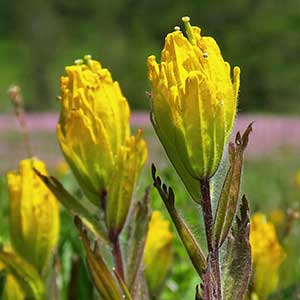Castilleja levisecta
Castilleja parviflora
golden Indian paintbrush, golden paintbrush
magenta paintbrush, mountain Indian paintbrush, mountain or rosy or small-flower paintbrush, small-flower paintbrush
few to many, erect, ± decumbent or creeping at base, unbranched, sometimes branched, hairs spreading, medium length and long, soft, mixed with short stipitate-glandular ones.
several or many, erect or ascending, unbranched except for short, leafy axillary shoots, glabrate proximally, hairy distally, hairs sparse, spreading, ± matted, long, soft, minute-glandular.
green to purple or brown-tinged, linear-lanceolate proximally, oblong-ovate or -obovate distally, 0.8–5.2 cm, not fleshy, margins plane, distalmost sometimes ± wavy, involute, 3–7(–11)-lobed, apex obtuse;
lobes erect to ascending, linear to linear-spatulate, very short, toothlike, usually arising from distal 1/3 of blade, apex rounded.
green or gray-green to purple-tinged or deep purple, often blackening on drying, narrowly to broadly lanceolate or elliptic, rarely linear, 1.5–5 cm, not fleshy, margins plane, sometimes ± wavy, flat, (0–)3–9-lobed, apex acute to acuminate or obtuse;
lobes spreading or ascending, linear, sometimes lanceolate, much narrower than terminal lobe, evenly spaced, short, apex acute.
2.5–25 × 1–4 cm;
bracts bright yellow throughout, or proximally greenish, distally bright yellow, sometimes deep yellow-orange, especially with age, oblong, elliptic, or obtuse to ovate, (0–)5–9(–13)-lobed, sometimes wavy-margined;
lobes erect to ascending, oblong, short to medium length, arising above mid length, central lobe apex rounded, lateral ones rounded to acute.
2–16 × 1–3.5 cm;
bracts proximally greenish, dull, deep purple, or reddish purple, distally pink, pink-purple, magenta, deep rose, crimson, cream, or white, sometimes red, pale orange, or red-orange, lanceolate to broadly elliptic or ovate, 3–7-lobed;
lobes spreading to ascending, linear, lanceolate, or lanceolate-acuminate, short to medium length, arising at or near mid length, apex obtuse to acute, central lobes sometimes rounded.
straight or slightly curved, 17–28 mm;
tube 12–15 mm;
beak exserted, adaxially green or greenish yellow, 6–8 mm;
abaxial lip yellow or greenish, reduced, not inflated, 2–3 mm, 25–33(–50)% as long as beak;
teeth ascending to erect, yellow, 0.5–1.5 mm.
straight or slightly curved, 12–30 mm;
tube 8–19 mm;
beak exserted or subequal to calyx, adaxially green-yellowish or red, 5.5–11 mm;
abaxial lip green, brown, or yellow, sometimes purple, reduced, slightly or not inflated and pouched, 1–3 mm, 20–45% as long as beak;
teeth erect, green, white, yellow, pink, or red, 0.5–2 mm.
distally yellow, 13–22 mm;
abaxial and adaxial clefts 4–9.5 mm, 30–40% of calyx length, deeper than laterals, lateral 2.5–4.5 mm, ca. 25% of calyx length;
lobes linear to narrowly oblong or narrowly lanceolate, apex obtuse, sometimes rounded to acute.
colored as bracts, 12–28 mm;
abaxial and adaxial clefts 6–15 mm, 40–70% of calyx length, deeper than laterals, lateral 1–8 mm, 10–35% of calyx length;
lobes narrowly to broadly triangular, sometimes distally expanded and flaring, petaloid, apex obtuse or acute, sometimes rounded.
= 24.
= 24, 48.
Castilleja levisecta
Castilleja parviflora
Castilleja levisecta is listed as threatened in the United States and endangered in Canada, where it is extremely rare. Most of its grassland habitat has been altered by development in the Puget Trough, and there are historical stations in the metro areas of what are now Victoria, Portland, and Seattle. For several decades, C. levisecta was considered extirpated from Oregon. However, recent reintroduction programs in Oregon and Washington have been very successful at reestablishing this species at several sites in the Willamette Valley. The bright yellow inflorescences often gradually age to a golden yellow color, unique in the genus.
Castilleja levisecta is in the Center for Plant Conservation’s National Collection of Endangered Plants.
(Discussion copyrighted by Flora of North America; reprinted with permission.)
Varieties 4 (4 in the flora).
Castilleja parviflora is a complex, geographically widespread, and often misunderstood species ranging from southeastern Alaska through much of British Columbia, southwestern Yukon, and the Rocky Mountains of extreme western Alberta and southward in the Cascade Range to central Oregon.
(Discussion copyrighted by Flora of North America; reprinted with permission.)
1. Corollas (18–)20–30 mm; calyces 20–28 mm; leaves (0–)3(–5)-lobed; Oregon, Washington. | var. oreopola |
1. Corollas 12–20(–25) mm; calyces 12–20(–28) mm; leaves (0–)3–9-lobed; Washington to Alaska, Alberta, and Yukon. | → 2 |
2. Bracts distally white to cream, sometimes suffused with pink to purple; herbs 0.6–2.7 dm; n Cascade Range, Washington and s British Columbia. | var. albida |
2. Bracts distally pink-purple, magenta, deep rose, or crimson, rarely white; herbs 1.2–5 dm; Olympic Mountains, Washington, w Canada, se Alaska. | → 3 |
3. Leaves (3–)5–9-lobed; corolla beaks 5.5–7 mm; Alberta, British Columbia, Yukon, Alaska. | var. parviflora |
3. Leaves (0–)3(–5)-lobed; corolla beaks (5.5–)7–9(–11) mm; s Vancouver Island, British Columbia, Olympic Mountains, Washington. | var. olympica |
- Local floras:
BC,
CA,
OR,
WA
- Local Web sites:
CalFlora,
CalPhotos,
Flora NW,
PNW Herbaria,
Turner Photog.
WildflowerSearch
iNaturalist (observations)
USDA Plants Database
- LBJ Wildflower Center
- SEINet
- Plants of the World Online
- Encyclopedia of Life
- Wikipedia
- Google Image Search


